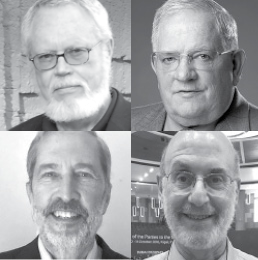In 1898, the British chemist William Crookes gave a talk before the British Association for the Advancement of Science entitled simply, “The Wheat Problem.” Crookes is best remembered for his work on vacuum tubes, and lenses that were precursors to today’s sunglasses, so his focus on wheat production probably startled his audience. Especially since his thesis was alarming: wheat was extracting more nitrogen from the soil than we could replenish, which resulted in ever lower yields and “a life and death question for generations to come.”
It took another decade, but in 1908, the German chemist Fritz Haber (later referred to as the “father of chemical warfare”) provided a solution to the wheat problem by demonstrating that ammonia, the main component for nitrogen fertilizers, could be synthesized. The manufacturing of ammonia for fertilizer is one of the great innovations of the 20th century. Some researchers estimate that its introduction in agriculture has since supported over 40 percent of global births.
But, as has been the case for many technological leaps, there were downsides. Today, the synthesis of ammonia accounts for a quarter of the annual greenhouse gas emissions of the entire chemical sector, as well as increasing nitrogen pollution of waterways through agricultural run-off. Other options are being explored — from synthesizing ammonia using plasma to low-temperature electro-catalysis — but the most intriguing solution is biological.
Some plants, mainly legumes like beans, have microbial partners with an amazing capability to extract and “fix” nitrogen directly from the atmosphere for immediate use by plants. What if that genetic function could be transferred directly to plants like corn? And that is exactly what is happening. Hundreds of millions of dollars are being poured into new approaches, and firms like PivotBio are making plants that they hope in the future will be self-fertilizing, addressing both environmental and food security challenges.
Over the last decade over $12 billion has been invested in new biotech startups and existing companies, with around $4 billion put forward in 2018 alone. The pandemic has riveted our attention on health care applications, but as a recent report from McKinsey notes, “More than half of the potential direct economic impact from biological technologies . . . is outside of health care, notably in agriculture and food, materials and energy, and consumer products and services.”
Some of these emerging applications you may have already heard about, or even tasted. Memphis Meats and Mosa Meat are growing beef, pork, chicken, and even duck meat from cultures in the lab, just two of the over 80 companies now working on cultured meat and seafood protein products using a process broadly referred to as cellular agriculture. These approaches are being applied to a broad spectrum of dietary products. Finless Foods, for example, is applying cellular agriculture technologies to grow fish cells in the lab. It isolates cells from fish tissue, feeds the cell cultures with nutrients to grow and multiply, and structures them into seafood products — all in local facilities, which further reduce transportation-related environmental impacts.
As another example, researchers at the Joint BioEnergy Institute, funded by the Department of Energy, have recently developed a plant biomanufacturing platform that was used to synthesize a new-to-nature biopesticide with novel antifungal properties. This suggests that plants can be used to sustainably manufacture molecules not possible with traditional chemical methods.
This all is the tip of the revolution in what is termed engineering biology and signals a shift from chemical to biological synthesis — to a new manufacturing paradigm. An inventory maintained by ELI to track emerging biotech products and applications now contains over 300 examples stretching across almost two dozen categories, from food to fuel to threat detection.
People are beginning to build with biotechnology. The sustainable building materials startup bioMASON injects microorganisms with sand in an aqueous solution to create bricks and other construction materials, a process that is not only faster than the traditional kiln-fired process, but it also releases no carbon because it does not require fuel or heat. Traditional brick making not only emits CO2 and other gases into the atmosphere, but often involves the removal of agriculturally productive topsoil. That can reduce agricultural yields by 60-90 percent. Another innovative and sustainable materials startup, Cruz Foam, uses one of the most abundant natural polymers on Earth, chitin from shrimp shells, to sustainably manufacture packaging materials, automotive parts, and consumer electronics.
Novel solutions to tackle indoor air pollution are in the pipeline. Researchers at the University of Washington have inserted a mammalian gene (CYP2E1) into ivy plants to increase their detoxifying potential. The gene “codes” for an enzyme that breaks down some of the volatile organic compounds found in homes. The researchers estimate that a biofilter made of these genetically modified plants could deliver clear air at rates similar to commercial home filters.
Next-generation biotech firms are exploring new avenues to address old, intractable environmental challenges. A new effort at Allonnia, backed by Gates Ventures and the Battle Memorial Foundation, will search for enzymes or microbes that could tackle the long lasting risks from so-called “forever” chemicals — per- and poly-fluoroalkyl substances found in thousands of nonstick, stain repellent, and waterproof products.
Biotech is starting to provide promising solutions aimed directly at the global carbon cycle that could help address the 37 gigatons of carbon released annually into the atmosphere — creating carbon-neutral or de-carbonization options for a number of economic sectors, such as agriculture, construction, and some forms of transportation — aviation, for example — that are less amenable to the adoption of traditional carbon-neutral strategies. Aviation currently accounts for 2 percent of global carbon emissions. Unfortunately, plane fuel weight restrictions eliminate many of the other carbon-neutral options being considered for the transportation sector, such as electric motors or fuel cells. But researchers at the University of Manchester in England have re-engineered the genome of a bacterium (Halomonas) that grows in seawater to produce next-generation bio-based jet fuels.
Research is also targeting direct interventions in the carbon cycle, by increasing the carbon capture efficiencies of plants and trees. Today, around 120 gigatons of carbon is removed by terrestrial photosynthesis on an annual basis. So even small improvements could have large impacts on carbon removal while simultaneously improving crop yields and food security. Research is underway to redesign photorespiration and CO2 fixation pathways, optimize light reactions during photosynthesis, and transfer carbon-concentration mechanisms from algae and bacteria into other plant chloroplasts.
Biotech is creating new avenues for climate change adaptation — for instance, the engineering of drought- and disease-resistant crops. Researchers at the Innovative Genomics Institute at Berkeley have developed cacao plants engineered to thrive as the climate warms and dries the rain forests where they normally grow the crop. As many as 50 million people worldwide make their living from the industry.
Long term, biology can be a key to creating a circular economy, where decentralized and distributed biomanufacturing systems are designed to use a variety of inputs. These include chemicals from industrial off-gases; syngas generated from municipal solid waste, organic industrial waste, forest slash, and agricultural waste; or reformed biogas. These systems provide a variety of outputs, from fuels to food or vaccines. This kind of production flexibility is one objective of the new BioMADE initiative developed by the Department of Defense and the Engineering Biology Research Consortium. The seven-year award includes $87.5 million in federal funds and is being matched by more than $180 million from non-federal sources, including state governments.
This future rests on the increasing ability to engineer biology to enable what researchers at the firm Zymergen have coined biofacturing. Jason Kelly, the CEO of Ginko Bioworks, predicts, “As we get better at designing biology, we’ll use it to make everything, disrupting sectors that the traditional tech industry hasn’t been able to access.”
Old biotech was messy, expensive, and imprecise. It would often take large companies hundreds of millions of dollars and years to change the properties and behavior of one molecule. No more. To paraphrase Stanford University economist Paul Romer, the new biology is about better recipes, not just more cooking.
Today’s biology goes beyond the “study of complicated things,” as the British evolutionary biologist Richard Dawkins once put it. Over a decade of significant investments by organizations like the National Science Foundation, the Department of Energy, and the Defense Advanced Research Projects Agency have turned biology into what some have termed a Type 2 innovation platform, similar to the Internet, which “consists of technological building blocks that are used as a foundation on top of which a large number of innovators can develop complementary services or products.” Think of today’s biology not as a science, but as a precision-manufacturing platform — digitally interconnected, increasingly automated, flexible, and cost-effective.
These novel biological engineering approaches share one critical characteristic — the ability to run experiments quickly, testing hypotheses, learning, adjusting — what some have termed the Design-Build-Test-Learn cycle. Making things faster has been lauded as the single most important determinant of manufacturing productivity and was historically a critical focus of companies such as IBM (via Continuous Flow Manufacturing), Motorola (Short Cycle Management) and Westinghouse (Operating Profit Through Time and Investment Management). Jack Newman, a co-founder of the biotech firm Amyris, observed that the DBTL cycle “was transformational, allowing the operational translation of fundamental science into stuff.”
These new capabilities have spawned radically new business models, allowing the disaggregation of the historical value chains that have long dominated medical and agricultural biotech. This is happening even at a time when large first-wave biotech firms are tending toward consolidation, bordering on monopolistic aggregation, such as the recent mega-merger of Monsanto and Bayer. But simultaneously, what some term de-verticalization is creating viable business niches in new economic ecosystems, where many new firms work to design the molecules that can be scaled by larger firms downstream in the value chain.
But going to scale remains a large challenge facing the bioengineering community. This will mean moving from a few milligrams of a novel microbe in the lab to kilograms, kilotons — and beyond in the case of commodity products. Going from lab to commercial-scale production will require a bridge, a distributed and sharable infrastructure that can be co-developed with industry. It will need a new workforce with the necessary skills to engineer large-scale, distributed, and flexible production facilities and the ability to build life cycle and sustainability considerations into manufacturing processes and their associated supply chains.
And going to scale with potentially hundreds or thousands of large-capacity bioreactors will bring the new biotechnology face-to-face with the public and media, raising questions about safety, security, and governance. Moving forward, there is an urgent need for regulatory and policy reinvention. There is an old adage in Silicon Valley that innovation requires a combination of “rich people,” “nerds” and “risk taking.” That may not be enough. There are some important ways in which biology differs from other innovation platforms. The most crucial are the regulatory, security, and public perception barriers that may hinder the introduction of new products into the market.
Regardless of these challenges, over a decade of progress and emerging business opportunities have motivated many countries to develop bioeconomy strategies designed to expand their industrial base and accelerate the commercialization of biotech innovations. There are now nearly 60 bioeconomy strategies for nations and for a number of macro-regional areas like the European Union and East Africa. Thousands of people now attend the biennial Global Bioeconomy Summit held in Berlin (virtual this year). The United States was an early leader, developing a government-wide National Bioeconomy Blueprint in 2012 under the Obama administration. It emphasized the role of the biosciences and biotechnology in creating new economic opportunities.
The 2012 Blueprint was the first and for the better part of a decade the only bioeconomy strategy that featured biotechnology as a critical platform technology to drive economic benefits in the biomedical, agricultural, environmental, energy, and industrial sectors. The Blueprint promotes making strategic and non-overlapping research and development investments, facilitating transitions from lab to market, increasing regulatory efficiency, enabling public-private partnerships, and supporting strategic workforce development. In the years that followed the release of the Blueprint, the Obama administration realized a number of outcomes relating to all five of its strategic objectives.
For instance, significant research investment enabled the discovery of CRISPR/Cas9, which became a genome-editing technology that has significantly accelerated the ability to quickly and precisely edit genomes of microbes, plants, and animals. The Department of Agriculture expanded the BioPreferred Program, the federal biobased procurement system that aims to provide market certainty for the growing industry sector. Then in 2015, Executive Order 13693, titled Planning for Federal Sustainability in the Next Decade, required federal agencies to set biobased procurement targets. The Office of Science and Technology Policy convened the Food and Drug Administration, EPA, and USDA to execute the 2017 Update to the Coordinated Framework for the Regulation of Biotechnology, aimed to increase transparency, ensure safety, streamline regulatory processes, and accelerate the translation of bioinventions to market. There was also a successful public-private partnership between LanzaTech and Pacific Northwest National Laboratory that resulted in the development and testing of the first bio-jet fuel, used to power a Virgin Atlantic Airlines flight from Orlando to London. Finally, in addition to launching a technical roadmap in 2019, progress has been made toward the Blueprint’s workforce objective through a public-private partnership known as the Engineering Biology Research Consortium, which established a four-month industry internship program for Ph.D. candidates to help train the next generation workforce for engineering biology.
Since the National Bioeconomy Blueprint was released, a number of additional important advances have occurred. In 2019, the House of Representatives passed legislation, the Engineering Biology Research and Development Act of 2019, with the aim of directing the Office of Science and Technology Policy to implement a national engineering biology research and development program that would coordinate relevant federal agency investments and activities. The Senate followed with the Bioeconomy Research and Development Act of 2020, with a similar aim. Also in 2020, the National Academies for Science, Engineering, and Medicine released a study, “Safeguarding the Bioeconomy,” that articulated — for the first time — the value of the U.S. bioeconomy, which it estimated at $959 billion annually. The report argued that the United States needs a White House-level standing committee of scientists, economists, and national security experts to develop a strategic plan to promote and protect the United States’ biology-based industry.
These actions portend a future wherein a strategic, coordinated federal effort is possible. Toward this end, additional steps are needed. For instance, the Biden administration should consider creating an office to coordinate interactions between the government and businesses, large and small, on bioengineering. It should be a one-stop shop — similar to what the National Nanotechnology Coordinating Office did for the National Nanotechnology Initiative.
To realize a strategic, coordinated U.S. bioeconomy, policymakers will need to advance not only authorization for a national engineering biology research and development program, but also appropriations to fund it. Any appropriations should be linked to regular evaluation of program impacts and proactive anticipation and management of emerging risks to help ensure public confidence in new and novel products and applications. A recent meta-analysis of the national bioeconomy strategies found that, “Only a minority . . . even mention the potential negative consequences of bio-based transformations.”
Significant strategic infrastructure investments are needed. For example, a new constellation of state-of-the-art, networked biomanufacturing facilities, positioned near sources of biomass, could not only maximize the use of renewable resources but also create high-tech jobs in rural areas. Facilities in Iowa, for instance, could use agricultural waste from corn as a feedstock, those in southeastern states could utilize switchgrass, and coastal production plants could take advantage of marine species such as seaweed and various kelp varieties. This biomanufacturing “commons” could also serve to reduce greenhouse gas emissions and the generation of toxic waste as compared to traditional chemical manufacturing. And it would create value from problematic wastes such as forest slash and agricultural residues.
Building on the progress started by the National Bioeconomy Blueprint developed during the Obama administration, the incoming Biden team has a tremendous opportunity for a renewed commitment to the U.S. bioeconomy as an important pillar of its commitment to climate action. Its new “Made in All of America” effort is aimed at revitalizing domestic manufacturing with inclusive policies and environmental stewardship,
Working together with the 117th Congress, the new administration has potential to realize a Clean Manufacturing Act, aimed to mobilize the diverse talent of the American workforce, accelerate sustainable manufacturing innovation, maximize the use of the billion tons of sustainable, renewable biomass the United States has the ability to produce, and significantly reduce negative environmental impacts of manufacturing.
As nearly sixty countries around the world try to refine their bioeconomy strategies to include biotechnology to help reboot economies crippled by the coronavirus pandemic, the United States has little time to waste in developing strategies to keep its leadership position in biomanufacturing. Over a decade ago, Neri Oxnam at MIT’s Media Lab observed that “the biological world is displacing the machine as a general model of design.” That revolution has happened. The future of manufacturing has arrived. TEF







